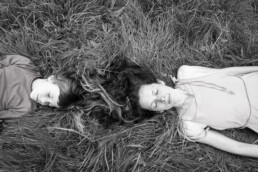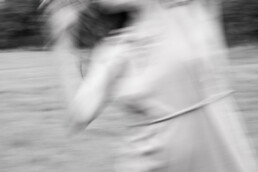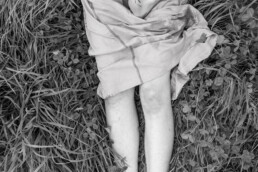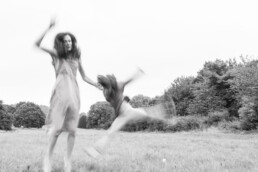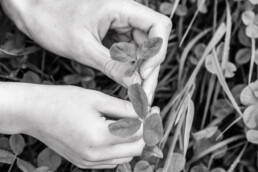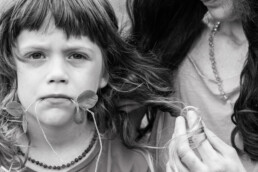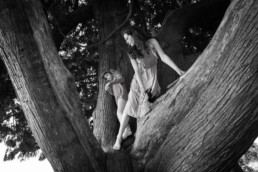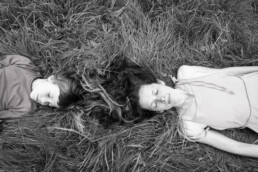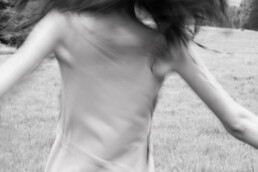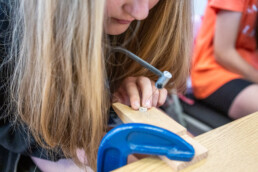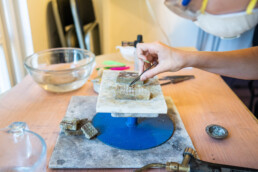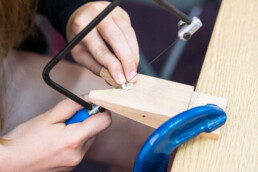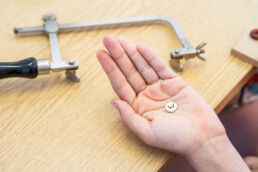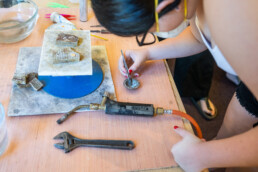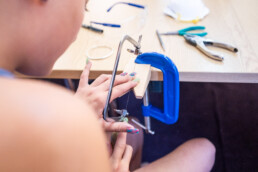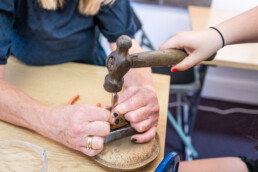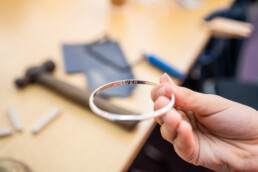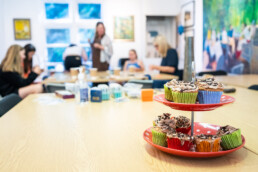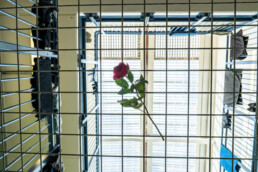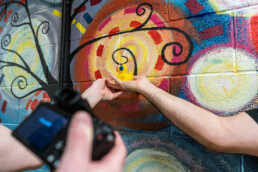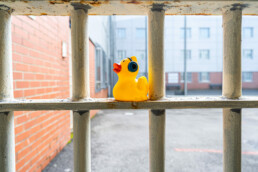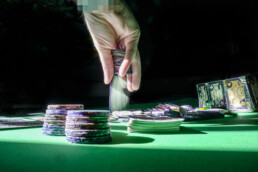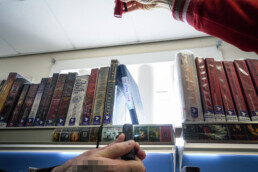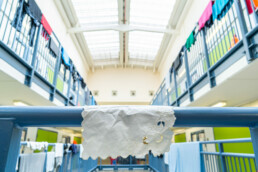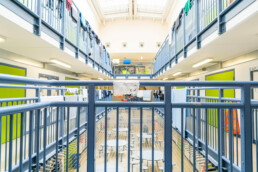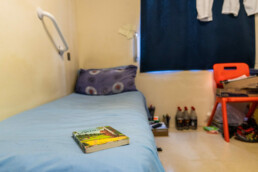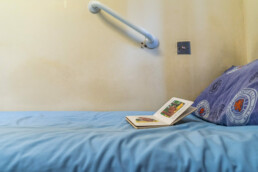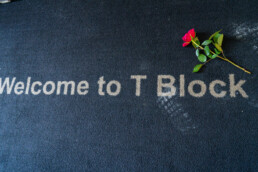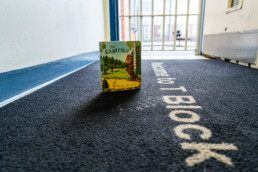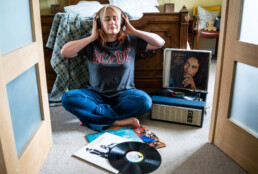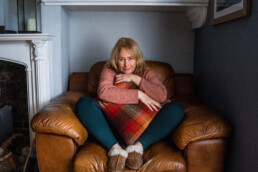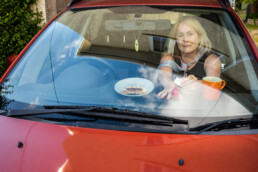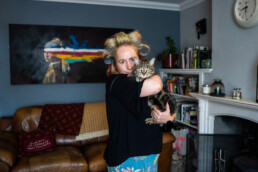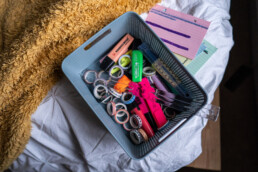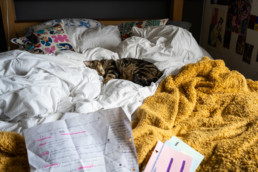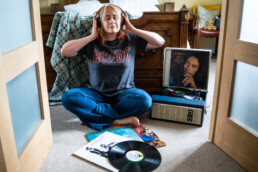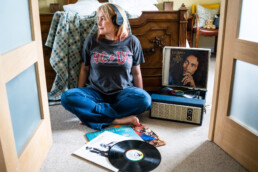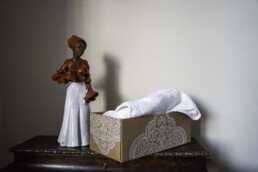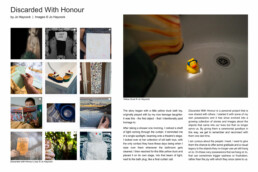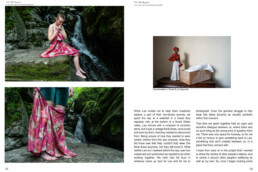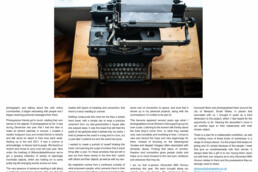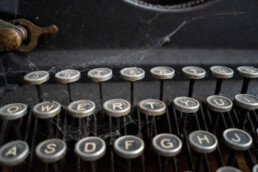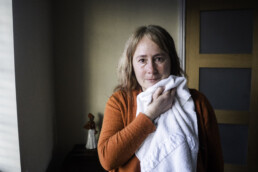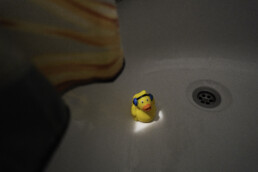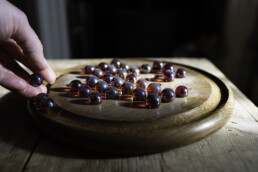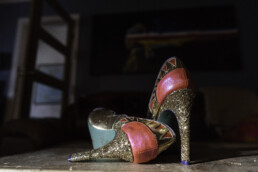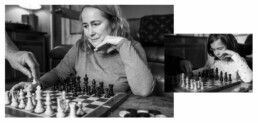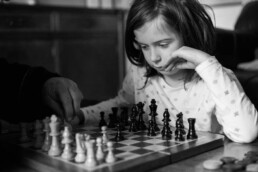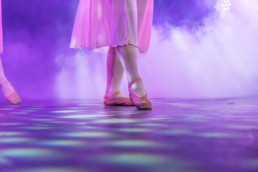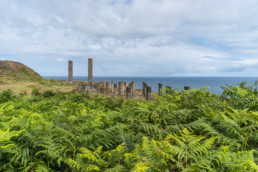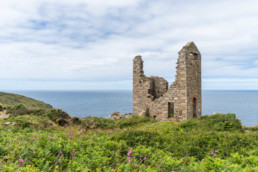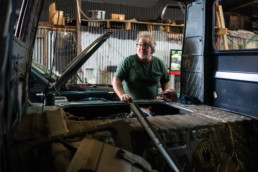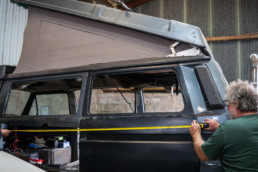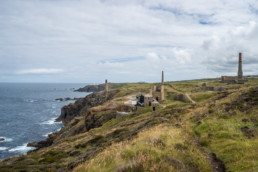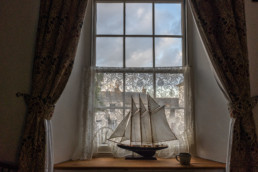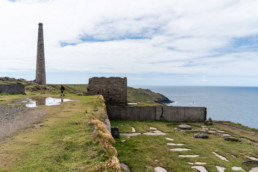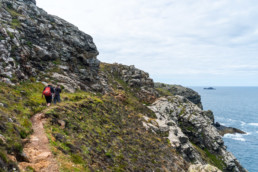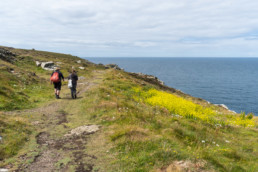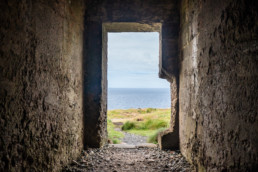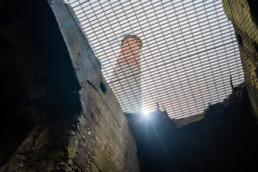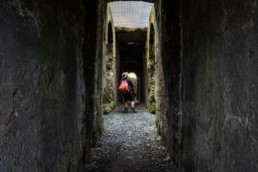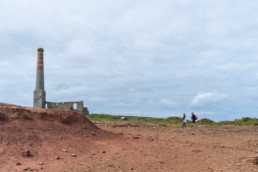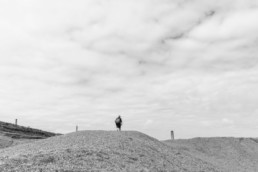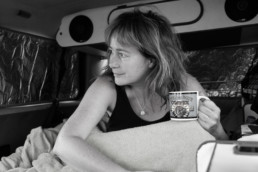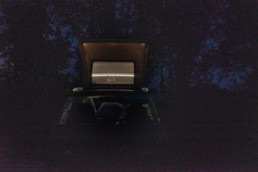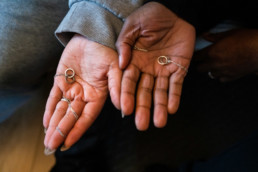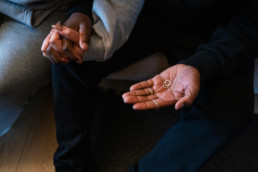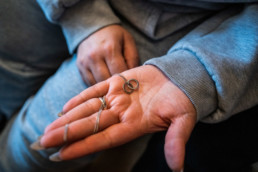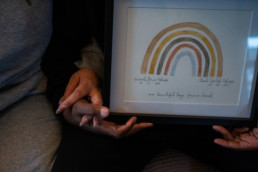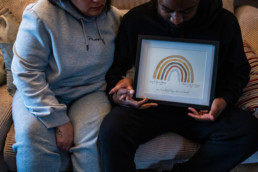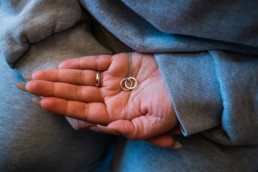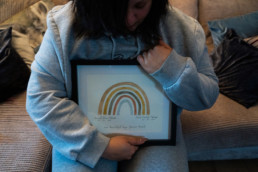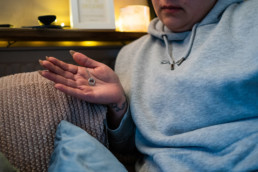The Visual Word | From Above the Surface
Poetry in Pictures
As an ACDC track played through the tiny tinny-sounding speaker of a smart phone, we danced
without care in a long-grassed meadow one late summer’s day. Spinning and swaying until giddy,
to the point of me not knowing where my movement ended and her’s began. With camera in hand,
I followed her in that moment and almost as default, we visually formed her words between us.
I’ve long been a believer in the magic of roots that grow and intertwine with some of the people that
I meet in life. Sharing and seeing the natural patterns that emerge with them and getting to explore
some of the places they, in turn, connect with.
Nicola Dellard-Lyle, mother and poet, became one such person when I met her and her family at a
wedding of mutual friends last summer. So when Nicola sent me a message several months later, I
felt more of that root grow. Her words read like this…
“I’m writing the last lines of my first book of poetry, called From Above the Surface. It’s a collection
of poems I have written through, and out of, some difficult times I have experienced in motherhood.
It goes further back to some of the triggers and shadows from my past.
Even though I’ve been supported over the years, and I felt like I had healed, I have now found the
words to finally bring me back home. So each poem is a shot sent out from what felt like the
deepest dark. I hope it will resonate with those mothers out there who are struggling.”
Weekly conversations began between us, with me realising that this was no one-stop photographic
brief. It was one that was sensitive, organic and fragile yet courageous. We talked a lot about
trees, the freedom of being above ground yet roots keeping us grounded. This was the beginning
of how our creative brief grew between us, to be able to feel our way into the right visuals to
honour her words.
As I read the through the collection of poems for the book, From Above the Surface, I can see
clearly how Nicola continues to draw her mothering wisdom from her seven year old son, Caleb.
In the time that I spent with them both, it touched me how important Caleb’s voice and ideas have
been in creating these photographs. He joined in all our planning conversations, as well as taking
part in the day itself. When he wasn’t featuring in the photos, he would stand at my side, quietly
observing and guiding his mother. And even through his joyful child-like play, I was left in no doubt
that he is wise beyond his young years.
I strongly feel that this most natural guidance in strength and growth that comes from our children,
begins before they are even born. It reminds me of the countless times I’ve quietly looked to my
own daughter for those next steps in how to be more me, as well as how to parent her through
challenging times.
The day with Caleb and Nicola was spent among the trees and meadows: our playground.
We explored woodland grottos, where we climbed and swung from branches. Danced barefoot,
spinning in circles and falling over into the long grasses. All the while, I was aware that this day in
nature’s own playground was very much their theatre stage and their direction. I was to simply be
an observing audience, recording and visualising her words.
As the day unravelled further, we became ever more excited in discovering more places to
photograph and play, and I felt profoundly honoured for the gifted
responsibility of breathing visual life into Nicola’s poetic journey of motherhood.
“I found a scrap of paper in a notebook only the other day, it was where I scrawled the first poem I
wrote ‘Return’, the first poem I wrote in a space of clarity after this difficult time.This book and this journey has been a big healing process, and I now realise it
had been a turbulent time and I’d not been there in myself. I also now realise that I’m
back.”
Published in the Winter 2023 issue of JUNO Magazine
From Above the Surface is available from Nicola’s website HERE.
Seasons of Motherhood October 2023 | Adventuring Families
“The project grew from a desire to explore other people and their connection to the coastline.”
When Jez began his arts project, Coastline. He set out with a camera attached to his bike that he pushed beside him, as he filmed the entire sequence along the way. Drawing and tracing the physical border between land and sea, while recording the conversations with people he met along the way.
Jeanie was my little co-driver, as we navigated the remote and ‘un-satnavable places he’d end up in, meeting him with our cosy camper van, a hot drink and a wild family sleepover. It was home-from-home to her and we’d often find ourselves having our own adventures in those spaces of time inbetween.
The project took an unexpected pause after he completed all of Wales’ coastline and pretty much all the south coast of England. He had a cycle accident on the commute home from work one day and the years that followed saw him work so hard to regain physical and mental health.
He’s recently found fresh curiosity and new inspiration, to go back to the start of where he left off.
While I found this old photograph for a feature I’ve recently written called Family Adventures in the Autumn issue of JUNO Magazine. This one of her, curled up in the back of our camper van with Tiger, as her father off-loads his bike from a full day on the coastal path.
My little Team Vehicle Support mate, my partner in crime (in a more teen-kind of way these days).
This is Artifact Motherhood; a collaboration of artists and mothers from around the world, who have come together to share our stories of the joys and struggles of our journey. Through our writings and visual records, we want to create memories that are more than photographs with dates written on the back. These are the artefacts we are leaving behind for our children and for generations to come.
Next up in the blog circle is the talented artist, Kirsty Larmour
Learning Self Worth | Cyfannol Women's Aid Photographic Project
“I stamped the word ‘safe’ on the back of the bracelet, so that if I get scared I can rub my fingers over the letters and remember that I’m safe”
I am proud of myself. Five seemingly simple words we don’t often say and they are not heard often enough in our teenagers’ world. I make no secret of my own parenting challenges around raising a teenaged girl. Constantly scrambling around for the right words of encouragement and wisdom and regularly feeling like “ you just don’t get it mum.”
While I watched these five words, along with words like ‘safe’ being engraved on the inside of bracelets, made by girls of similar ages to my own daughter, I felt certain parallels in her life to theirs. But I also know that the dynamics of their family lives are so very different to her own.
“I sometimes get anxious so be having these words close to me it reminds me that I can achieve anything”
It was several years ago that I joined a Women’s Aid organisation to photograph some of the support services for women and children who have experienced domestic abuse. Watching these courageous women and their children become empowered as they began realising their self-worth has, without doubt, shaped my approach over the years to the relationships I witness and form within the communities I photograph. By seeking out the can do’s and the shall’s gives me a connection and a visual to the hope that I want to portray in my work.
So as the legacy of that project has continued over time, it was earlier this year that Cyfannol Women’s Aid asked me to make a series of photographs to illustrate some of its incredible support groups.
The first group I attended was a girls’ summer jewellery-making workshop, where they each created a silver bangle over a few weeks. With the talent and creative support of a local silversmith and the emotional and guiding support of the group facilitator, I watched as these bangles took on their layers of meaning and ownership. Holding each girl’s story as they wove them intrinsically and intentionally into beautifully crafted silver bangles.
It was in this space that we all got lost in the art of making, owning stories and celebrating them with their chosen words to remind them not only of their friendships and self worth, but that they also each created their own legacies that day.
“ I know there are many others like me, but everyone’s journey is different and that’s why I chose these words on my bracelet”
The gentle chinking of these letters being immortalised on these silver bangles, was the affirmation and daily reminder that the wearer is safe, that she is powerful and that she is proud of herself.
The Freedom of Art in Prison | A Photographic Workshop
The Freedom of Art in a Prison
“Have a good weekend miss” he said as we left on that second Friday afternoon of our
photography workshop, “you too” I replied.
It then hit me, that these common exchanges of pleasantries I have with folk I meet most Fridays in
my day-to-day world, are now hanging with new meaning and a new perspective. Because his
weekend ahead looks very different to mine and with far fewer opportunities to make it truly feel
like ‘a good weekend.’ We looked at each other for a moment and didn’t state the obvious, my
apologetic smile for his feelings of incarceration spoke the words into that gap.
I have recently been part of an artists’ collaboration where we’ve delivered a series of workshops
to residents and staff at Parc Prison in South Wales. I always knew that the photographic element
of these workshops would likely be the most challenging to think up, set up and take inside a
prison, perhaps even the most contentious. Mainly due to the expected issues around clearance of
cameras and not being able to take in or out my memory cards. There is also the Prison’s brief to
consider, on what types of images can be shown, whilst adhering to anonymities outside the
prison’s walls.
This was already beginning to conflict with the very layers and processes of my artistic approach.
Which went on to gift me with new angles to find and to tell an authentic and more contemporary
way of documenting some the residents’ stories, as well as some of my own, during my time spent
at Parc.
So I chose to share my personal photographic project, Discarded With Honour with some of the
people living there. It’s a personal project that began in 2021, where I photographed the no-longer-
used objects of mine and others, in places that gave us a sense of connection with them, recalling
these objects’ stories. Sometimes, I’d get rid of the object, sometimes I would keep it, but let go of
feelings associated with it that were no longer helpful to me. Using this personal project was the
pivotal point in linking a photojournalism-styled workshop inside a prison, by giving voice to our
possessions to share some incredibly personal stories.
Some of the men who took part in these workshops were fathers themselves, though each
participant spoke of their family by using objects, owned or borrowed, to share and relay some
intimate stories, which in turn opened up discussions between us that held no boundaries. That
gave a freedom of speech they quite possibly wouldn’t of had within their daily lives behind bars.
Within the first half an hour, I realised that this was one of the most receptive group of people we
could have worked with. So I threw down my workshop notes and told them that we were going off-
piste, that they would now be leading this workshop. It was unexpected and rewarding and what
followed were the most incredible and honest conversations between us all.
These conversations were sparked by objects such as my daughter’s Gruffalo book, how one
father, Richard reminisced about reading this to his own children each night. How another
participant, Daniel shared some words from his journal, the only link he currently has between a life
before and a life right now.
I was surprised at how fiercely protective I became over the men’s photographs, even before
seeing them on screen. Like Tom’s handmade poker chip set, where he gave such thought and
intention about where to place it and photograph it within the limited access to space that we had
to show a connection as he wanted to. Like my daughter’s old bath toy duck, now named ‘Dave’ by
Lewis, who became innovative in the Media Centre’s library as we searched for books with pictures
of water to connect Dave with.
Dee, my co-workshop facilitator and I would talk about the images made that day on our drive
home each week. Describing every one them from memory and hoping that they would make the
cleared list. There was one instance where I found myself explaining to member of staff that I felt
anxious at their offer to crop out what I knew to be an integral part of one of my photographs,
because it displayed one of the men’s tattoos. It’s now that I understand the safeguarding reason
around this ruling of ‘no distinctive or identifiable markings’ and the conversation led to a solution of
me editing these images in-house alongside the men, who got the opportunity to take part in the
post-editing process.
By using Discarded With Honour as a stepping stone and inviting this group of men to take part,
gave us each an equal platform to share some intimate stories through our objects. It gave us each
a language to begin some honest conversations through the art of photography, giving full freedom
in those few hours. I hope we can continue with this project, sharing the freeing role that art and
creativity holds for even the most diverse of communities.
Creative Roots is a unique programme delivered by the artists’ collective, Das Clarks. Where the
programme inspired those living and working in confinement to explore creative freedom. With
sessions delivered on the residential wings of Parc Prison, Creative Roots involved an initial
foundation programme of creative exploration back in 2021. The foundation activity developed into
specialised sessions in print making, painting, photography and writing. The work featured in a
performance-based exhibition during May 2023 – one inside Parc Prison and the other open to the
public in Newport, South Wales. The artwork and performances were created by residents, staff
and the artists involved in the project.
Das Clarks are Gareth Clark, Marega Palser and Dee Rogers with Bill Chambers, Marion Cheung
and Jo Haycock.
Featured in the Late Summer 2023 issue of JUNO Magazine
Walking on Eggshells | Seasons of Motherhood
I’m learning to pause
and I’m learning to choose my battles. In fact, I’m learning to walk gently and
with intent across eggshells these days, as a mother to a teen.
We’re fast approaching the two-year mark of when I last held up my camera to photograph her
within our day-to-day family life, when she said “no photos please.” So this unplanned series of
self-portraiture carries on, with me continuing to photograph myself in the situations I see her in,
but she won’t let me. This photographic series has started to include me attempting to visualise a
few of my escapisms, from these constant eggshells I walk over, beside her, to constantly show
that I’m here.
Navigating a young person through school exams, along with some anxiety and self
consciousness, has me feeling all sorts of out of control during this tricky and intricate time. I find
that I’m having to learn super-quickly, from which pieces of my well-meaning advice are said out
loud, or whether I ask certain questions like which subjects she’s revising today; I’m often met with
an eye-rolled silence or various dramatic ways of saying “leave me alone.” I now try to rehearse
any motherly advice in my head a few times over before deciding if I should say them out loud.
Sometimes I have out-loud moments on the days that I drive her to school. It’s these precious car
journeys that have become important to us both. A time when we grab coffee and toast for the road
and get to align ourselves for that day ahead. But sometimes we don’t talk at all, we just turn up
the music and sing Glee soundtracks very loudly and it’s these moments I will always treasure.
When I start conversations about how proud I am of her, about how she’s navigating first-time
challenging situations in life her own way, I find myself explaining that I was never that smart and
aware as she is, when I was her age. I’m usually met with a response of “what is it with all the
inspirational speeches mum, and why do you squeeze them all into one car journey?”
I know I’m not alone, my teen-mum friends and I regularly confer, listen and commiserate in each
others’ stand-offs with our kids. All the while never losing hope that everything will make sense and
be more harmonious again. After all the day our babies were born, we gave them our hearts and
from that day onwards we’re right here sharing the highs and lows, for richer for poorer as the
saying goes.
With all the insightful parenting podcasts collectively listened to, the ‘I’ve been there myself’ blog
posts read, along with the dipping in and out of ‘you’ve got this’ styled-books, I have an unwavering
certainty without any of the aforementioned. Which is this; my grounding comes from our ever-
evolving relationship between a mother and daughter, and that how we navigate this time between
us will always be uniquely ours.
So choosing which conversations come from my thoughts to my mouth has become a finely tuned
art form. And as we sing along to that final Glee track before turning into the school gates, I glance
sideways and know that she’s going to be a force of nature in this world, she’s going to be just fine.
As featured in the Summer 2023 issue of Juno Magazine
This is Artifact Motherhood; a collaboration of artists and mothers from around the world, who have come together to share our stories of the joys and struggles of our journey. Through our writings and visual records, we want to create memories that are more than photographs with dates written on the back. These are the artefacts we are leaving behind for our children and for generations to come.
Next up in the blog circle is the talented artist, Diana Hagues
RPS Women in Photography magazine feature
Nothing compounds the importance of keeping a space for the unexpected in my work than this – a simple hand towel. Used to wrap a precious ornament from my late-grandmother’s house after she had passed away.
It was this towel that still held the scent of her perfume when it arrived into my home. I tried to preserve the scent in a bag, held in a box and put into a drawer. A year later I pulled it out and the scent had gone.
Discarded With Honour began as a personal photographic project that is now shared with others. It is a growing collection of stories and images about the objects that came into our lives and that now no longer serve us. By giving them a ceremonial goodbye in this way, we get to remember and reconnect with them one last time.
I was invited to share some words and images about this project with the Royal Photographic Society’s Women in Photography magazine, WE ARE at the end of last year.
I am curious about the people I meet and I want to give them the chance to offer some gratitude and a visual legacy to the objects they no longer use yet they still hang on to. The communities I continue to share this project with through workshops and monthly contributions, will form a series of exhibitions and hopefully, one day, a book.
It’s these very possessions that we hang on to, that can sometimes trigger a sadness or frustration, rather than the joy with which they once came to us. But they tell the richest stories about us that we need to share.
Seasons of Motherhood January 2023 | A Game of Chess
What started as a now-and-then created photograph became so much more than a game of chess.
The years have rolled by from that original scene of a little girl playing a game of chess with her dad one Sunday morning. My inspiration to re-create that scene with me in it, had no more layers other than some symbolic connection to life’s choices and events… like moving chess pieces around the board. Though I felt so many more layers to this recreation the morning after, as I witnessed her stepping back and working her way through a true life challenging situation, how she turned it into something so great.
I could not be prouder and more in awe of her grace, true grit and determination, yet what makes me happier still, is that she feels this too.
J: “I actually did it”
Me: “I always knew you could. I’m so proud of you, you must be proud of yourself too”
J: “I am.”
Me: *lets a few happy tears of relief slip at today’s chosen chess move.
This is Artifact Motherhood; a collaboration of artists and mothers from around the world, who have come together to share our stories of the joys and struggles of our journey. Through our writings and visual records, we want to create memories that are more than photographs with dates written on the back. These are the artefacts we are leaving behind for our children and for generations to come.
Next up in the blog circle is the talented artist, Paige Rains
Seasons of Motherhood | The Dance Show October 2022
From now on
It was two days before the world closed its doors to a pandemic, yet the show went on. Now here we are two years later with the tribute titled show. From Now On was the last song played that evening in March 2020.
So much has happened in that time. The challenges and revelations, the slowing down and speeding up of life. Still that show goes on.This weekend you are one of 208 dancers treading the boards across this stage once more. I am photographing every dance, with as much back stage excitement and frenzied routine polishing as I can capture. Spreading myself across three vast dressing rooms from dancers aged three years and up, to both sides of the stage.
And then there is you.
________________________________________________________________________________
This is Artifact Motherhood; a collaboration of artists and mothers from around the world, who have come together to share our stories of the joys and struggles of our journey. Through our writings and visual records, we want to create memories that are more than photographs with dates written on the back. These are the artefacts we are leaving behind for our children and for generations to come.
This entry is the fifth in a series called “Seasons of Motherhood” and is meant to be one picture and one caption that represents our current journey/season of motherhood.
Please visit the next artist in our blog circle, the talented Jess Cheetham and continue through all the artists until you get back to me.
This weekend’s dance show is called From Now On, as it was the last performance from those years ago. The button has been reset, yet we cannot deny the lifetime of what these years have brought about. Why would we?
Artifact Motherhood September 2022 | A van-less summer
Our family adventures took a different path this summer for a number of reasons.
Our beloved camper van and my family’s much-loved holiday home on wheels. Has been undergoing major restoration. It’s been off the road for months. We always knew that this would be the year of different family adventures for us. We want to honour all those thousands of miles and far-flung destinations it’s gifted us, so we have chosen to gift it back a complete refit.
For selfish reasons, for all the adventures we yearn for and are yet to have.
I’m going to pause the van-less adventures and rewind back to the beginning of the year. Where we unexpectedly experienced a bereavement within our family. It continues to shift and shape the foundations of our daily lives. Finding that world kept turning while we tried to stand still, we found ourselves amidst school exams and some post-pandemic anxiety.
I booked two different overseas trips in an attempt to regroup and breathe together as a family. The first was a trip to Spain during the Easter break, but you tested positive 48 hours before we were due to leave. The second attempt was in June, to Sicily, after your last exam. The airline cancelled that flight that morning, three hours before taking off.
We were sat in a cafe at 8.30am and clicking ‘yes’ to an old cottage in Cornwall.
We headed off instead, to a place we thought we knew so well. Yet during this week, we found new wonders and experiences in the familiar landscapes. Explored the old tin mines buildings that frame the wild and dramatic coastline.
Walking east one day, west the next and talking to people we’d never met, possibly will never meet again.
* This season’s story is an edited extract from the next JUNO Magazine Autumn issue.
Artifact Motherhood is a collaboration of artists/mothers from around the world. Sharing stories of the joys and struggles of our journey. Our hopes and dreams for our children. With little nuggets of wisdom here and there. These are more than photographs with dates written on the back. These are the artefacts we are leaving behind for our children and the generations to come.
Please visit the next artist in our blog circle, the talented Hollie Stokes and continue through all the artists until you get back to me.
There's No Rule Book for Grief | one family's journey
Talking about baby loss
When I first started to consider writing about baby loss, I was, initially, tentative and apprehensive. Not only because I’m acutely aware of how personal a story this is for each family that has experienced it, but because it is an experience which I’m grateful never to have been through.
I honestly didn’t know what reaction I would get, particularly in response to calling out to families who have experienced this. The first big question that came up for me was, how do you approach someone who’s grieving to talk about it for a feature? All I know is that the experience of baby loss is not talked about nearly enough, and asking people how they feel at any time in their grieving process does not happen enough either.
Inviting a family to share a part of their personal and emotional journey with a stranger felt daunting to me.
Then, quite suddenly and unexpectedly, we found ourselves in our own grieving process. The significant difference here was that this was at the end of life, not the beginning of life.
The complex layers of emotions that followed found me explaining to my 15-year-old daughter that there is absolutely no rule book for grief; it is unique to each person. It’s theirs to own, be in and live with, as they need and want to. It was then that I was introduced to Pytsje through a friend of mine.
Pytsje and her husband, Bruce, have two boys, aged 11 and 8 years old. They are a warm and open family with a strong faith and community within their local church. The kind of community that offers a helping hand in bringing up each other’s children, and an unspoken support for one another in times of need.
In 2019, Pytsje discovered she was pregnant with twins. At around 17 weeks pregnant, she went into early labour, and sadly, she lost one of the babies. At 20 weeks, her waters broke. She went into hospital where she and the surviving twin were monitored. As the local hospital didn’t have the specialist equipment needed in their baby unit, they were transferred to another hospital over 50 miles away.
The logistics of Pytsje’s stay in a hospital this far from home, and over the school holidays, were intense to manage, with the boys spending periods of time with various family members across the country, to enable Bruce to make the two-hour round trip on most days to be with his wife.
After four weeks in hospital, Pytsje gave birth to a baby boy. He lived for three days.
At first, Bruce was reluctant to be part of our conversation, however, I feel his words have more impact than perhaps he realises. The delicate balance between the experience and knowledge of medical staff – from seeing these processes multiple times in their work – and their understanding of one family’s circumstances, might be tested by their overstretched roles and hospital bed shortages.
He poignantly added, “These events can become second nature to a doctor, as it’s likely that they know what’s coming next. They see these situations all the time, so perhaps their awareness of us is challenged, as parents who are experiencing this trauma for the first time. All I kept thinking in those earlier weeks was, my baby is still alive.”
We talked about how their church and community gave them all the support they needed during this time. From the practical acts of kindness, such as bringing meals and offering childcare, to the spiritual acts of their faith and being in others’ prayers. Although they were given support through organisations such as Sands, it was their church family, as well the help from their own families, that they say they would not have got through those early months without.
I got up to leave, feeling emotional and in awe of their courage and honesty. We’d agreed between us that the photographs would be symbolic, around two treasures they own in memory of their twins: a hand-painted rainbow illustrating each birth, along with two personally made silver necklaces worn by each parent, engraved with their babies’ names. Just as I reached for the door, I asked what they might say to someone grieving the loss of their baby.
“You have to remember that it is not your fault and it’s really OK to not feel OK. It’s also important to acknowledge and accept the pain – it’s real and it will feel OK again one day. There is a huge difference between asking how someone is, compared to asking how someone is feeling, as knowing they are willing to listen will help you to talk.”
This features in the Spring 2022 issue of JUNO Magazine

